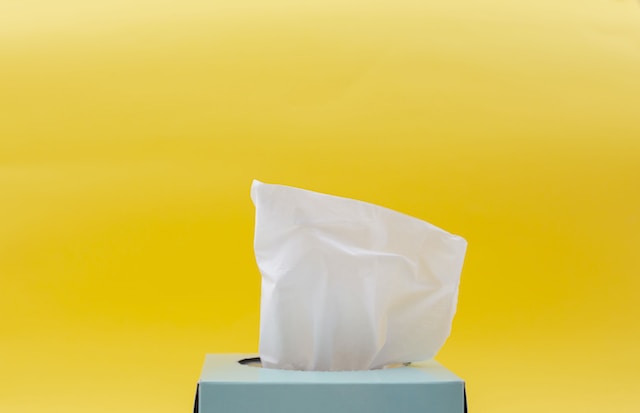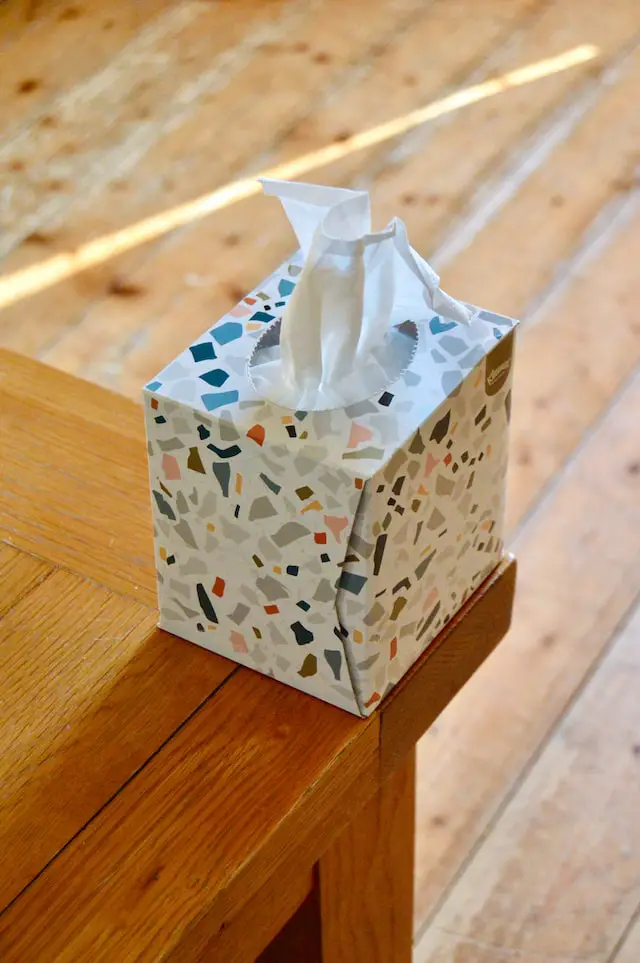Buffered tissue paper has a pH level that is higher than 7, while unbuffered tissue paper has a pH level that is lower than 7. The main difference between these two types of tissue paper is their absorbency levels; buffered tissue paper is more absorbent than unbuffered tissue paper.
What is buffered tissue paper?
(Photo by Diana Polekhina on Unsplash )

Buffered tissue paper refers to a type of tissue paper that has been treated with an alkaline substance, such as calcium carbonate, to increase its pH level. The purpose of buffering is to neutralize any acids present in the paper or the surrounding environment, thus providing protection against acid migration and acid-induced deterioration.
Buffered tissue paper is commonly used for archival and conservation purposes, especially for delicate and sensitive items like artwork, photographs, textiles, and historical documents. By maintaining a slightly alkaline pH, buffered tissue paper helps to mitigate acid degradation, discoloration, and brittleness that can occur over time.
The buffering process creates a reserve of alkaline material in the tissue paper, which can act as a barrier to prevent the migration of harmful acids from other materials in contact with the object. This buffering effect helps to preserve the integrity and longevity of the items by reducing the risk of acid-induced damage.
It is important to note that while buffered tissue paper provides protection against acidic deterioration, it may not be suitable for all materials. Some artifacts, such as certain photographs or artworks made with sensitive pigments, may require the use of unbuffered tissue paper to avoid any adverse chemical reactions. It is recommended to consult with conservation professionals or experts when determining the appropriate type of tissue paper for specific preservation needs.
What is unbuffered tissue paper?
Unbuffered tissue paper refers to a type of tissue paper that has not undergone any alkaline treatment or buffering process. It is typically characterized by a neutral or slightly acidic pH level, closer to the pH of the surrounding environment.
Unbuffered tissue paper is commonly used in archival and conservation practices, particularly for materials that are sensitive to alkaline conditions. It is often preferred for items such as photographs, artwork with delicate pigments, and textiles that may react adversely to alkaline substances.
Unlike buffered tissue paper, unbuffered tissue paper does not contain alkaline reserves to counteract acids. Instead, its purpose is to provide a chemically stable and inert material for wrapping, interleaving, or padding delicate objects. By using unbuffered tissue paper, the risk of introducing potentially damaging alkaline substances to sensitive materials is minimized.
Unbuffered tissue paper is often used in combination with other archival materials and techniques to ensure the long-term preservation of artifacts. It is crucial to consider the specific preservation needs of the items and seek advice from conservation professionals when determining the appropriate materials and methods for safeguarding valuable or fragile objects.
Buffered Vs. Unbuffered tissue paper – Key differences
The key differences between buffered and unbuffered tissue paper are as follows:
pH Level: Buffered tissue paper has been treated with an alkaline substance to increase its pH level, typically around 7.5-9.5, while unbuffered tissue paper has a neutral or slightly acidic pH, closer to 7 or below.
Acid Neutralization: Buffered tissue paper contains alkaline reserves that help neutralize acids, providing protection against acid-induced deterioration. Unbuffered tissue paper does not possess this acid neutralization capability.
Compatibility: Buffered tissue paper is suitable for a wide range of materials, but may not be ideal for sensitive items that can react adversely to alkaline conditions. Unbuffered tissue paper is specifically preferred for such sensitive materials.
Protection Against Acid Migration: Buffered tissue paper acts as a barrier, preventing the migration of harmful acids from other materials in contact with the object. Unbuffered tissue paper does not provide this protective barrier.
Reversibility: The alkaline treatment in buffered tissue paper is not reversible, meaning it cannot be easily removed once applied. Unbuffered tissue paper does not undergo any chemical treatment, making it inherently reversible.
Consider these differences along with the preservation needs and compatibility of your materials to determine whether buffered or unbuffered tissue paper is the more appropriate choice for your specific application.
The benefits and drawbacks of buffered tissue paper
(Photo by Alexander Grey on Unsplash )

Buffered tissue paper offers several benefits in preservation and conservation practices, but it also has some drawbacks that should be considered. Here are the benefits and drawbacks of buffered tissue paper:
Benefits:
- Acid neutralization: Buffered tissue paper helps neutralize acids present in the paper or surrounding environment, protecting delicate items from acid-induced deterioration.
- Preservation: It helps to maintain the integrity and longevity of artifacts by reducing the risk of discoloration, brittleness, and other acid-related damage.
- Protection against acid migration: The alkaline reserve in buffered tissue paper acts as a barrier, preventing the migration of harmful acids from other materials in contact with the object.
- Versatility: Buffered tissue paper is suitable for a wide range of archival materials, including artwork, photographs, textiles, and historical documents.
Drawbacks:
- Incompatibility: Some sensitive materials, such as certain photographs or artworks with delicate pigments, may react negatively to the alkaline properties of buffered tissue paper.
- Limited acid resistance: While buffering helps mitigate acid degradation, it does not provide permanent protection against all acidic substances.
- Risk of misapplication: If buffered tissue paper is used inappropriately for materials that require unbuffered conditions, it may cause unwanted chemical reactions or damage.
- Reversibility: The alkaline treatment in buffered tissue paper is not reversible, meaning it cannot be easily removed once applied.
Considering these factors, it is important to assess the specific preservation needs of objects and consult with conservation professionals to determine whether buffered tissue paper is suitable for a particular artifact or if alternative preservation methods should be considered.
The benefits and drawbacks of unbuffered tissue paper
Unbuffered tissue paper offers distinct advantages and disadvantages in preservation and conservation practices. Here are the benefits and drawbacks of unbuffered tissue paper:
Benefits:
- Compatibility: Unbuffered tissue paper is suitable for sensitive materials like certain photographs, artworks with delicate pigments, and textiles that may react adversely to alkaline substances.
- Chemical stability: It provides a chemically inert and stable material for wrapping, interleaving, or padding delicate objects, minimizing the risk of introducing potentially damaging alkaline substances.
- Versatility: Unbuffered tissue paper can be used in combination with other archival materials and techniques to ensure the long-term preservation of a wide range of artifacts.
- Risk reduction: By using unbuffered tissue paper, the potential negative effects of alkaline residues on sensitive materials are minimized.
Drawbacks:
- Lack of acid neutralization: Unbuffered tissue paper does not contain alkaline reserves to neutralize acids, which may increase the risk of acid-induced deterioration over time.
- Limited acid protection: Without buffering, unbuffered tissue paper provides limited protection against acidic substances from the surrounding environment or other materials in contact.
- pH instability: Unbuffered tissue paper tends to have a neutral or slightly acidic pH, making it more susceptible to fluctuations in the pH of the surrounding environment.
- Material specificity: Unbuffered tissue paper may not be suitable for all archival materials, and its usage needs to be carefully considered based on the specific preservation needs of the object.
It is crucial to assess the preservation requirements of individual artifacts and seek professional advice to determine whether unbuffered tissue paper is the appropriate choice for a particular item, or if buffered tissue paper or alternative preservation methods should be considered.
Which type of tissue paper do you need?
To determine the type of tissue paper needed, it is important to consider the specific requirements of your project or preservation needs. If you are dealing with sensitive materials that may react negatively to alkaline substances, unbuffered tissue paper would be a suitable choice. On the other hand, if you are looking for acid neutralization and protection against acid-induced deterioration, buffered tissue paper may be more appropriate. Assess the compatibility and preservation needs of your items, and consult with professionals if necessary, to make an informed decision on the type of tissue paper required.
Featured Image By – Pixel Rich on Unsplash








